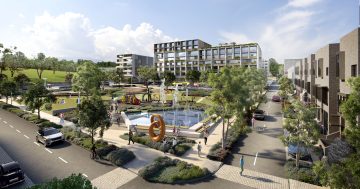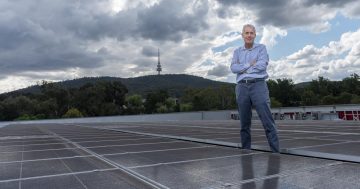
Emeritus Professor Barbara Norman from the University of Canberra. Photo: Tyler Cherry.
Canberra has a lot going for it: abundant green spaces, great local neighbourhoods, and amazing national arts and cultural facilities. We have a legacy of far-sighted planning to thank.
We enjoy walks around Lake Burley Griffin and cycle through the vastness of trees at the National Arboretum. We walk our dogs in suburbs that connect into parkland and increasingly travel through our planned transport corridors by light rail and electric buses.
So much of Canberra’s every day is thanks to the bedrock of solid planning that underpins the national capital.
Canberra’s infrastructure and services play a huge role in community health, tourism and economic prosperity – not to mention overall happiness levels. They also play a significant role in our city’s future as we move further into a climate change-impacted world.
Canberra’s great planning has contributed to who we are, our very identity as a city today. That’s a strong foundation to draw on as we look to the future to address how we can play a leading role in mitigating, adapting to and living with climate change. Collaboration is essential to achieving this.
Canberra and the surrounding NSW regions rely heavily on each other, from the Southern Tablelands to Snowy Monaro and Bega Valley. We each offer access to medical services, cultural and educational institutions, creative arts hubs, agriculture, national parks, and more. Together, we offer a unique tourism package for domestic and international visitors.
We are seeing significant population growth across these regions – the Centre for Population predicts Canberra’s population will reach 550,000 in 2032-33. The ACT is currently undertaking a planning reform process, and the NSW South East and Tablelands has reached the final draft stages of its regional plan to 2041.
Considering that growth and planning, and the prioritisation of sustainable development for our future, we need to take stock and embed some core planning principles that can underpin the evolution of our collective regions.
Experience shows that where councils and jurisdictions collaborate and provide a consistent, long-term plan for regions, it boosts public and private investor confidence, with huge benefits for the community.
It is time to prepare one integrated plan for the Australian Capital Region. Both sides of the border can’t afford to do their own thing any longer. As the two separate planning processes come to a head in 2023, we have an excellent window of opportunity to produce one integrated sustainable regional planning statement to show the broader context and provide certainty for managing urban growth in the ACT and surrounding region.
Affordable housing designed for resilience and sustainability, climate change mitigation and adaptation, local and regional transport, even better water management, cleaner renewable energy, and environmental and biodiversity protection are within reach, with a joint commitment by NSW and the ACT to good strategic planning to guide infrastructure and planning decisions. The active involvement of First Nations peoples across our region is essential to this.
This Canberra Day, I’m celebrating Canberra’s achievements in urban planning and sustainable development and their roles in building our city’s identity. But I am also looking to how we can continue this legacy for our future.
Barbara Norman is an Emeritus Professor at the University of Canberra and Visiting Fellow at the ANU and advises on sustainable development, coastal planning and climate change adaptation.
Barbara is the former Chair of the ACT Climate Change Council, Director of Canberra Urban and Regional Futures, Professor of Urban and Regional Planning at UC, and more. She is co-chair of the United Nations Planners for Climate Action and Deputy Chair of the Australian Coastal Society.






















